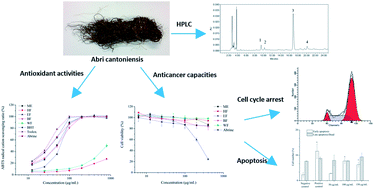In vitro antioxidant activities and anti-proliferative properties of the functional herb Abrus cantoniensis and its main alkaloid abrine
Abstract
Abrus cantoniensis is a common and popular vegetative food consumed as beverage, soup and folk medicine in the tropical and subtropical areas of Asia. It has been claimed valuable for cleansing toxicants in the liver. However, the functional effects of A. cantoniensis have not yet been scientifically explored. This study comprehensively evaluated the in vitro antioxidant and anti-proliferative capacities of the herbal extract and the main alkaloid abrine. Abrine was qualitatively and quantitatively determined in methanol extract (ME) using HPLC-DAD and LC-MS/MS. The results showed that ME, ethyl acetate fraction (EF) and abrine exhibited comparable ABTS radical cation scavenging activities and reducing power to two commercial antioxidants (BHT and Trolox). The EF exerted strong cellular antioxidant activity and selective cytotoxicity against three cancer cell lines in a dose-dependent manner. Biological assays revealed that the EF induced cell cycle arrest at G2/M and apoptosis in MCF-7 and Hep3B cells after 48 h of treatment. Thus, A. cantoniensis exerted potent cellular antioxidant and anti-proliferative properties, highlighting why it has been traditionally used as a functional food.


 Please wait while we load your content...
Please wait while we load your content...